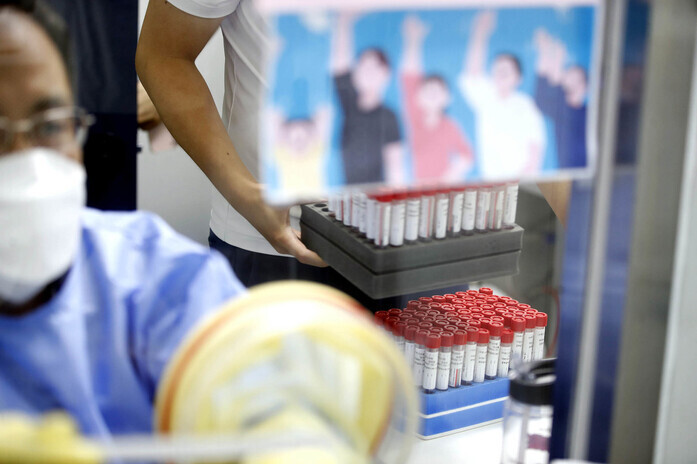hankyoreh
Links to other country sites 다른 나라 사이트 링크
S. Korea topped world in relative COVID-19 cases last week; daily deaths forecast to hit 140 next month

As the local resurgence in COVID-19 cases approaches its peak, South Korea’s rate of new confirmed cases last week was found to be the highest relative to population for any country in the world.
Some analysts predict the latest domestic resurgence will pass its peak around late August, with critical cases and deaths respectively reaching as high as 900 and 140 per day in early September.
A visit to the international statistics website Our World in Data on Tuesday showed South Korea had 16,724 new confirmed COVID-19 cases per 1 million people last week (Aug. 7–13) — the highest rate anywhere in the world. The daily average was thousands higher than the second and third place countries: the Marshall Islands with 14,577 and Japan with 11,228.
In a Central Disease Control Headquarters (CDCH) briefing Tuesday, Korea Disease Control and Prevention Agency Commissioner Peck Kyong-ran said, “Recently, confirmed cases have been occurring at the highest level in South Korea.”
In particular, she observed the “high incident rates around people aged 19 and under, a large percentage of whom are not vaccinated, and people in their 20s and 30s, who are highly active.”
According to CDCH weekly trend data, an average of 121,836 people per day tested positive last week, up by 25.2% from the week before.
At the same time, changes in the testing system are also a factor in South Korea registering the world’s highest COVID-19 incidence rate.
“About the only countries anywhere that have maintained the same diagnostic testing system as before the Omicron variant are South Korea, Japan, Taiwan, New Zealand and Australia,” explained Jung Jae-hun, a professor of preventive medicine at Gachon University and member of the national infectious disease crisis response advisory committee, in a telephone interview with the Hankyoreh.
Jung added that the reason for the relatively high case counts was the fact that “these countries are doing a good job of finding infected people.”
Indeed, the World Health Organization has urged caution in interpreting confirmed case and death statistics for different countries. Confirmed case counts may be significantly lower than actual infections in countries where overall testing is down due to a change in the testing strategy.
Experts predicted South Korea’s current resurgence would peak at between 135,000 and 240,000 confirmed cases per day during August. According to disease control authorities, modeling by three research teams predicted that critical COVID-19 cases would reach as high as 830 to 920 by early September, with 100 to 140 deaths from the virus per day.
In the past two weeks, the number of new COVID-19 patients in critical condition increased by 450, with deaths calculated as averaging 47.1 per day over the course of the week. Based on the analysis’s predictions, severe illness and deaths from COVID-19 could double to triple over the next month.
Indeed, clusters of infections at long-term care hospitals and other vulnerable facilities nearly quadrupled from 32 in the first full week of July (July 3–9) to 122 in the first week of August (July 31–Aug. 6). As time passes since the administration of third vaccine doses, the percentage of confirmed cases involving high-risk patients aged 60 and older has risen from 14.3% to 21.7% in the last month.
“With the recent rise in infections among high-risk populations, we’re seeing many cases involving severely ill patients being hospitalized in poor condition,” said Eom Joong-sik, a professor of infectious disease at Gachon University Gil Medical Center.
“Given all the different variables, including the reinfection rate and immunity, we should be preparing for higher-than-anticipated numbers of patients with severe symptoms,” he added.
By Lim Jae-hee, staff reporter
Please direct questions or comments to [english@hani.co.kr]

Editorial・opinion
![[Column] Has Korea, too, crossed the Rubicon on China? [Column] Has Korea, too, crossed the Rubicon on China?](https://flexible.img.hani.co.kr/flexible/normal/500/300/imgdb/original/2024/0419/9317135153409185.jpg) [Column] Has Korea, too, crossed the Rubicon on China?
[Column] Has Korea, too, crossed the Rubicon on China?![[Correspondent’s column] In Japan’s alliance with US, echoes of its past alliances with UK [Correspondent’s column] In Japan’s alliance with US, echoes of its past alliances with UK](https://flexible.img.hani.co.kr/flexible/normal/500/300/imgdb/original/2024/0419/2317135166563519.jpg) [Correspondent’s column] In Japan’s alliance with US, echoes of its past alliances with UK
[Correspondent’s column] In Japan’s alliance with US, echoes of its past alliances with UK- [Editorial] Does Yoon think the Korean public is wrong?
- [Editorial] As it bolsters its alliance with US, Japan must be accountable for past
- [Guest essay] Amending the Constitution is Yoon’s key to leaving office in public’s good graces
- [Editorial] 10 years on, lessons of Sewol tragedy must never be forgotten
- [Column] A death blow to Korea’s prosecutor politics
- [Correspondent’s column] The US and the end of Japanese pacifism
- [Guest essay] How Korea turned its trainee doctors into monsters
- [Guest essay] As someone who helped forge Seoul-Moscow ties, their status today troubles me
Most viewed articles
- 1[Column] The clock is ticking for Korea’s first lady
- 2Hong Se-hwa, voice for tolerance whose memoir of exile touched a chord, dies at 76
- 3After 2 months of delayed, denied medical care, Koreans worry worst may be yet to come
- 4[Column] Has Korea, too, crossed the Rubicon on China?
- 5[Correspondent’s column] In Japan’s alliance with US, echoes of its past alliances with UK
- 6US overtakes China as Korea’s top export market, prompting trade sanction jitters
- 7Samsung barricades office as unionized workers strike for better conditions
- 8All eyes on Xiaomi after it pulls off EV that Apple couldn’t
- 9More South Koreans, particularly the young, are leaving their religions
- 10John Linton, descendant of US missionaries and naturalized Korean citizen, to lead PPP’s reform effo